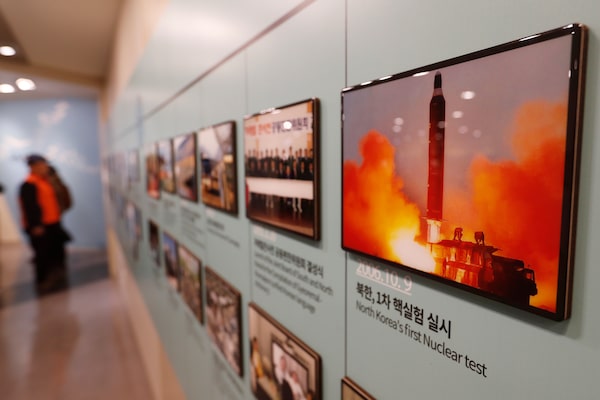
An image showing a recent North Korean missile launch is displayed at the Unification Observation Post in Paju, South Korea.Ahn Young-joon/The Associated Press
Andrew Hammond is an associate at LSE IDEAS at the London School of Economics.
What will be underneath the United States’ Christmas tree this year? If North Korea’s latest threat is any indication, it might be even worse than a lump of coal.
In early December, with nuclear negotiations stalled, Ri Thae Song – a first vice-minister at the North Korean Foreign Ministry – called for a “new path" and, more menacingly, added: “It is entirely up to the U.S. what Christmas gift it will select to get.”
That new path could include resumption of intercontinental ballistic missile launches capable of reaching the U.S. mainland, which had been suspended since 2017, or the possibility of new nuclear tests. These scenarios would represent a serious setback to U.S. President Donald Trump as he enters his re-election year, especially since he’s boasted about this moratorium as a key foreign-policy success.
The coming month may well be a pivot point for the peace process. China will play host to South Korean President Moon Jae-in and Japanese Prime Minister Shinzo Abe for a broadly focused Dec. 24 trilateral summit, and North Korea will likely rise to the top of agenda. And this week, China and Russia called on the United Nations Security Council to terminate sanctions on key North Korean exports such as coal, iron ore and textiles, with the nominal goal of enhancing the livelihood of the civilian population. Moscow and Beijing have also suggested that the estimated 100,000 North Korean nationals working abroad should be allowed to repatriate earnings; critics say that this money only supports the regime’s nuclear and ballistic missile programs. These diplomatic initiatives, opposed by Washington, highlight a fracture in what was previously a more unified international effort.
Other storm clouds threatening the U.S.-North Korean dialogue have continued to gather. According to U.S. intelligence, Pyongyang has increased production of fuel for nuclear weapons since 2018. This is a significant embarrassment to the White House, as Kim Jong-un’s regime appears to have been trying to hide this activity at secret sites, while simultaneously seeking concessions from Washington, including over ending U.S. military exercises with South Korea.
The commitments in last year’s Singapore summit between Mr. Kim and Mr. Trump – which occurred before their second summit in Hanoi collapsed in February – are certainly vague. But at the heart of the logjam is the fact that there is a fundamental difference between Pyongyang and Washington over what next steps are needed to build confidence.
While Mr. Trump and much of the international community are expecting further concrete actions from Pyongyang, Mr. Kim and his allies argue that North Korea has already taken the major step of dismantling a nuclear test site in Punggye-ri, where nuclear tests “have been made impossible for good." As a result, it feels empowered to push hard for reciprocation measures beyond the halting of joint Washington-Seoul military exercises, and to “create situations [on the ground] in the peninsula] where [Pyongyang] would feel the decision to denuclearize was a right move."
What this underlines is the significant expectations gap that emerged out of the 2018 summit, which seemed to forget the failure of similar U.S. initiatives in the past, with the reasons including North Korea’s refusal to allow inspectors to verify its claims. Despite the hype – Mr. Trump declared the nuclear threat from North Korea to be “over” – that Singapore session was no more than a start to a sustained strategic dialogue, at best. But one would have been forgiven for hearing his rhetoric and believing he’d solved the immensely complicated process of de-escalating tensions in the world’s last Cold War-era frontier.
Even now, it is still not clear that the Trump team has a comprehensive or coherent strategy toward Korea. Moreover, there does not even appear to be agreement on what Mr. Kim’s purported “commitment to denuclearization” means in practice.
Mr. Trump continues to define this as unilateral disarmament; for Mr. Kim, it is much more about potentially lengthy negotiations in which North Korea is treated as an equal to the United States, thus giving him further propaganda wins. As a result, Mr. Kim will probably remain wary about making concrete commitments on specific time frames, let alone agreeing to full denuclearization in its literal sense.
As 2019 draws to a close, the historic potential opportunity offered by the North Korea negotiations hangs in the balance. A breakthrough – which could make this a central part of Mr. Trump’s foreign-policy legacy – can’t be ruled out. But the President appears just as likely to emulate other U.S. leaders who have failed to bring a sustained, peaceful outcome to one of Washington’s key foreign challenges. And at Christmastime, we know that regifting is generally bad etiquette.
Keep your Opinions sharp and informed. Get the Opinion newsletter. Sign up today.